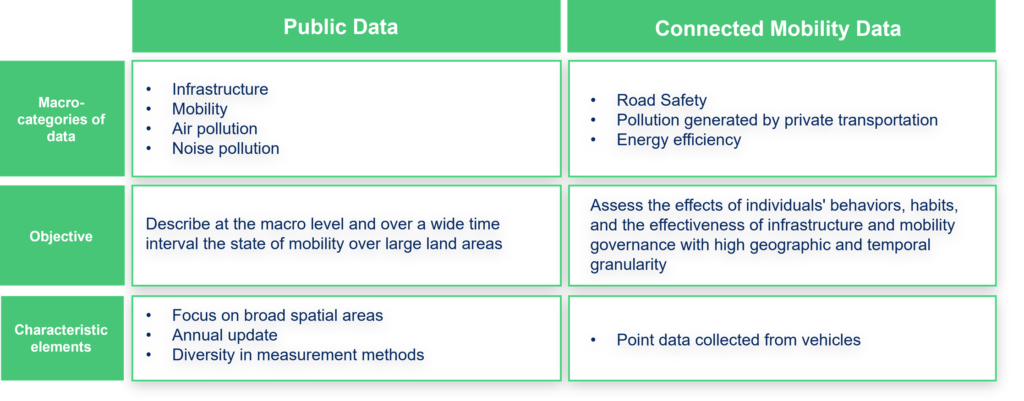The previous article in this series focused on the need to promote sustainable city development, substantiated by an assessment of the state and evolution of urban and suburban contexts and an analysis of the academic literature.
With this article, we continue the narrative of the importance of mobility as an enabler for the creation of Smart Cityecosystems and explore the hypothesis of measuring mobility sustainability performancethrough the combination of public data and connected mobility data.
In addition, the model underlying the Sustainable Mobility Dashboardby OCTO and The European House – Ambrosetti is introduced: a tool for administrations to measure and assess the sustainability performance of mobility within cities and, ultimately, for governance.
In order to improve the sustainability performance of cities, connected mobility plays a major role; thanks to the data generated by each individual vehicle and shared with the ecosystem, it will be possible to achieve what OCTO calls Vision Zero- zero traffic, zero pollution, zero accidents – closely linked to ESG (Environment, Social and Governance) parameters, which in turn are central to the new sustainability paradigm.
The analysis of traffic flows, the monitoring of driving behaviour, the monitoring of car health, the analysis of mobility flows, are all capable of generating environmental and economic benefits – e.g. reduction of pollution, reduction of accidents, more effective urban planning – as well as producing quantifiable benefits for people with a view to improving lifestyles and creating new services to be made available to citizens.
For example, it is possible to use connected vehicle technologies for access to urban resources (green areas and restricted traffic zones) considering not only the Euro level of the vehicle, but also and above all driving behaviour, kilometres driven within the areas and the resulting individual ecological impact. All this would result in a greater ‘democratisation’ of the management of green or restricted traffic areas, based on ‘participatory’ behaviour in the city’s sustainability objectives.
In fact, connected vehicle technologies increase transparency and participation in public affairs, while respecting privacy and having a very positive impact on the social sphere.
To date, there is no comprehensive indicator worldwide to assess the sustainability performance ofmobility.
The international standard ISO 37120:2018 certifying the sustainability of cities has only limited transport-related indicators in it, while the European Sustainable Urban Mobility Indicator(SUMI) for assessing urban mobility performancedoes not report any elements that can give indications on the adoption of city mobility governancesystems (e.g. accountability, planning, etc.) and many of the variables are difficult to collect or have a low degree of granularity and time depth.
OCTO and The European House – Ambrosetti believe that the data collected from connected vehicles and from observing the behaviour of individuals would make it possible to define new indicators and extend those already contained in the SUMI.
The OCTO and The European House – Ambrosetti Dashboard aims to provide public administrations with the ability to assess the sustainability performance ofurban mobility based on the integration of public information and information from connected mobility.
Combining public and connected mobility data, the Sustainable Mobility Dashboardwill provide a detailed view of urban mobility and is designed as a tool to improve the governance of cities and simultaneously accelerate the transition to increasingly sustainable ESG models.

Figure 1 The combination of public and connected mobility data in order to obtain a comprehensive view of the state of urban mobility. Source: elaboration The European House – Ambrosetti, 2023
With respect to public data, The European House – Ambrosetti identified 37 ESG indicators with data from 11 databases- Eurostat, Istat, ACI, ACEA, European Environment Agency, Care Database, Eurobarometer, EU Open Data Portal, EU JRC Database, UN Habitat Urban Data, Eurostat Urban Audit.
The polluting potential of vehicles, surface vehicle density, the injury and fatality rate of accidents on urban roads, the demand for local public transport, the presence of urban traffic, mobility and sustainable mobility plans and the development of MaaS initiatives are just some of the 37 indicators identified.

Figure 2 The breakdown of the 37 ESG indicators. Source: elaboration The European House – Ambrosetti, 2023
A first dashboard that can be realised with the collected public data relates Italian cities to selected environmental and social performanceindicators. This tool now allows some comparative analyses of mobility performancein different Italian cities, applying filters to combine the analysis views.
While public data aim to describe the state of mobility on a macro level and over a wide time interval over extended territorial areas, connected mobility data make it possible to assess the effects of behaviour, individual habits, the effectiveness of infrastructures and mobility governance with a high geographical and temporal granularity. All this is possible through point data collected from vehicles and related to three macro-categories: road safety, pollution generated by private transport, energy efficiency.
With respect to connected mobility data, OCTO can estimate, by means of proprietary algorithms, important indicators, including the travel risk indicator, the indicator of the level of pollutant emissions (CO2, NOx, etc.) and the energy consumption of an electric vehicle.
How these tools can be grafted into the operational processes of mobility stakeholders will be the subject of the discussion scheduled during the first Working Table of the Territorial Roadshow, during which an advancement of the measurement model elaborated by OCTO and The European House – Ambrosetti will be presented and its adoption methods and benefits for the stakeholders involved will be assessed: from citizens, to the administrators of companies, cities and enterprises of the mobility ecosystem as a whole.
Author:
The European House – Ambrosetti